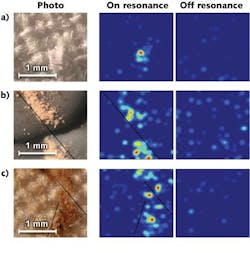STANDOFF DETECTION: SRS chemical detection is insensitive to substrate’s optical properties
One of the primary drawbacks of many standoff chemical-detection techniques is the need for specialized measurement setups that often require the chemical of interest to be placed on particular glass or metal substrates to eliminate background signals and/or improve reflectivity. Because explosive residues or biological molecules are typically found on a variety of colored and textured organic and inorganic surfaces in real-world war zones or public spaces, substrate-insensitive standoff-detection techniques are invaluable.
Borrowing methods from highly chemical-specific coherent anti-Stokes Raman spectroscopy (CARS) technology, researchers at Michigan State University (MSU; East Lansing, MI) have developed a single-beam stimulated Raman scattering (SRS) technique that is able to detect and identify trace quantities of explosives at 1–10 m standoff distances on a variety of substrates such as delicate absorbing cloth and textured plastic.1 The method uses a single femtosecond laser with 10 mW output power.
Selective Raman excitation
The principle behind SRS is that when pump and probe laser beams are incident on a molecule and have a frequency difference that matches a vibrational frequency for that molecule, selective Raman excitation of that vibrational transition occurs. This can be detected through changes in intensity of the pump and probe beams as stimulated Raman loss (SRL) and stimulated Raman gain (SRG), respectively.
In single-beam SRS, a single femtosecond laser with sufficient bandwidth to overlap essentially any molecular vibration and a computer-controlled pulse shaper are used to create both the primary pulse and a delayed replica pulse that are used to measure both SRL and SRG simultaneously. In the experimental setup, spectral phase shaping modifies the temporal profile of the femtosecond source to excite Raman modes in a sample under test. The femtosecond pulse and the delayed pulse (with different spectral phase but identical spectrum) are focused on the sample; reflected intensity data are collected and SRL and SRG are computed.
The SRS method enables a 3:1 or better signal-to-noise ratio with only a few (less than 10) laser pulses; a complete Raman spectrum can be obtained in a few seconds by scanning the pulse-shaper phases. With the phase tuned on-resonance for a particular molecular vibration, an image of the region containing that molecule can be built up by raster-scanning the region on-resonance and plotting either SRL or SRG. A typical 30 × 30 pixel area containing the analyte of interest can be imaged with 20 laser shots per pixel, indicating analyte concentration and location (see figure).
Single-beam SRS is sensitive enough to identify single microparticles of ammonium nitrate (NH3NO4); in fact, single 15 ng particles can be detected in as little as 20 ms on both cloth and plastic surfaces using a near-infrared 10 mW femtosecond-laser source. This is significant because there are few methods capable of detecting solid explosives with extremely low vapor pressures. The specificity of the method, which is based on Raman resonances, minimizes the occurrence of a false positive detection.
“Our system has detected single 20–30 ng particles deposited under the strict Army and DHS trace preparation conditions, not on ‘drop and dry’ approaches that are known to concentrate the samples,” says Marcos Dantus, MSU professor and president and CEO of BioPhotonic Solutions (also in East Lansing). “Our system can not only distinguish explosives selectively, it can identify different isomers by providing a spectrum of a suspected compound.” Dantus adds that the main drawback of the system is that the laser is not yet commercialized. He hopes that the U.S. Department of Defense will fund laser development.
REFERENCE
1. M. T. Bremer and M. Dantus, Appl. Phys. Lett., 103, 061119 (2013).

Gail Overton | Senior Editor (2004-2020)
Gail has more than 30 years of engineering, marketing, product management, and editorial experience in the photonics and optical communications industry. Before joining the staff at Laser Focus World in 2004, she held many product management and product marketing roles in the fiber-optics industry, most notably at Hughes (El Segundo, CA), GTE Labs (Waltham, MA), Corning (Corning, NY), Photon Kinetics (Beaverton, OR), and Newport Corporation (Irvine, CA). During her marketing career, Gail published articles in WDM Solutions and Sensors magazine and traveled internationally to conduct product and sales training. Gail received her BS degree in physics, with an emphasis in optics, from San Diego State University in San Diego, CA in May 1986.
